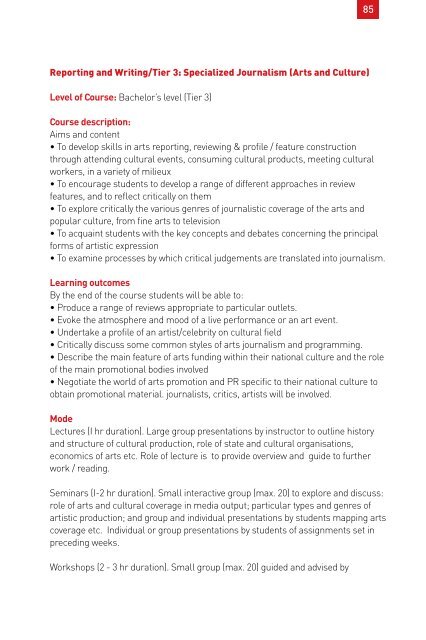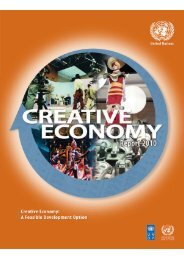Model curricula for journalism education for developing countries ...
Model curricula for journalism education for developing countries ...
Model curricula for journalism education for developing countries ...
You also want an ePaper? Increase the reach of your titles
YUMPU automatically turns print PDFs into web optimized ePapers that Google loves.
85<br />
Reporting and Writing/Tier 3: Specialized Journalism (Arts and Culture)<br />
Level of Course: Bachelor’s level (Tier 3)<br />
Course description:<br />
Aims and content<br />
• To develop skills in arts reporting, reviewing & profile / feature construction<br />
through attending cultural events, consuming cultural products, meeting cultural<br />
workers, in a variety of milieux<br />
• To encourage students to develop a range of different approaches in review<br />
features, and to reflect critically on them<br />
• To explore critically the various genres of journalistic coverage of the arts and<br />
popular culture, from fine arts to television<br />
• To acquaint students with the key concepts and debates concerning the principal<br />
<strong>for</strong>ms of artistic expression<br />
• To examine processes by which critical judgements are translated into <strong>journalism</strong>.<br />
Learning outcomes<br />
By the end of the course students will be able to:<br />
• Produce a range of reviews appropriate to particular outlets.<br />
• Evoke the atmosphere and mood of a live per<strong>for</strong>mance or an art event.<br />
• Undertake a profile of an artist/celebrity on cultural field<br />
• Critically discuss some common styles of arts <strong>journalism</strong> and programming.<br />
• Describe the main feature of arts funding within their national culture and the role<br />
of the main promotional bodies involved<br />
• Negotiate the world of arts promotion and PR specific to their national culture to<br />
obtain promotional material. journalists, critics, artists will be involved.<br />
Mode<br />
Lectures (I hr duration). Large group presentations by instructor to outline history<br />
and structure of cultural production, role of state and cultural organisations,<br />
economics of arts etc. Role of lecture is to provide overview and guide to further<br />
work / reading.<br />
Seminars (I-2 hr duration). Small interactive group (max. 20) to explore and discuss:<br />
role of arts and cultural coverage in media output; particular types and genres of<br />
artistic production; and group and individual presentations by students mapping arts<br />
coverage etc. Individual or group presentations by students of assignments set in<br />
preceding weeks.<br />
Workshops (2 - 3 hr duration). Small group (max. 20) guided and advised by

















